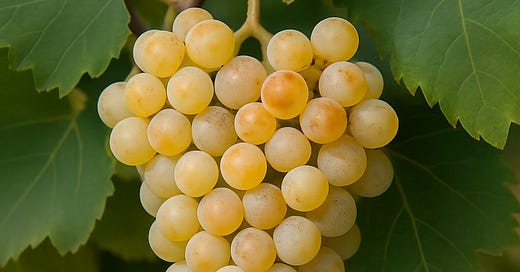The History of the Albillo Real Grape
The History of the Albillo Real Grape
Mitchell Rabinowitz
Albillo Real is a grape that doesn’t draw much attention at first. The berries are small, the skins are thin, and the surface is lightly coated with bloom that rubs off easily. When crushed, the aroma is restrained but distinct: pear skins, dry grass, almond. The flavor doesn’t come all at once. It develops gradually and without intensity.
The grape has a long presence in central Spain. It appears in 15th-century vineyard records, including Agricultura General by Gabriel Alonso de Herrera, who described the wine as clear in color, soft in taste, and suitable for aging. Its cultivation was mostly limited to areas near Madrid, Ávila, and parts of Castilla y León. It was grown in small, mixed vineyards. The grapes were used for local consumption or modest trade. It was never widely planted and was not used in high-volume production.
Albillo Real ripens early, which made it useful in regions with short or irregular growing seasons. But it produces low yields and is sensitive to rough handling, which made it difficult to manage in large operations. Its high glycerol content adds viscosity to the wine and gives it a smooth texture. These traits were not widely appreciated at the time, but they gave the grape a clear identity. The wines are pale in color, low in acidity, and medium in body. The flavor is subtle and can include notes of almond, hay, fennel, or white plum. These are not common flavor markers in most white wines, and that difference often kept the grape outside of mainstream attention.
In Gredos and Ribera del Duero, Albillo Real was often used in blends. It was planted alongside Garnacha or Tempranillo and used to add body or aromatics. It was not usually made as a varietal wine. Some growers saw its potential. Peter Sisseck, the winemaker behind Pingus, has argued that Albillo should be more widely accepted in Ribera del Duero because it brings useful aroma and texture. Over time, that view began to take hold. Winemakers like Comando G, Marañones, and Alfredo Maestro started working with Albillo Real as a primary grape. They used native yeast, didn’t filter the wines, and allowed the lees to remain during aging. These methods helped bring out the grape’s strengths.
Albillo Real does not produce wines with strong fruit or high acidity. Its value comes from shape and stability. When grown in granite or slate, the wines are firm and hold up well to air. They don’t oxidize quickly. They also age more slowly than expected for a white wine. With food, the wines don’t clash. They work best as part of the setting, not the centerpiece.
The name Albillo has caused confusion. Several grapes use the term, including Albillo Mayor in Ribera del Duero and Albillo Criollo in the Canary Islands, but these are genetically distinct. DNA research has shown that Albillo Real is a cross between Hebén and Folha de Figueira. In 2019, Albillo Mayor was approved as a white grape for DO wines in Ribera del Duero. Albillo Real is older and harder to find. It nearly disappeared not because of flaws, but because its advantages were subtle and not suited to large-scale production. It needed attention, and that was not something the market prioritized.
That has begun to change. In the Vinos de Madrid DO, Albillo Real became the leading white grape when the denomination was formalized in 1990. It is now being replanted with more care and purpose. In places like San Martín de Valdeiglesias, prices for Albillo vineyards and grapes have gone up. Growers are returning to the traditional sites and treating the grape with more attention. It is no longer planted to support something else. It is being used for itself.




